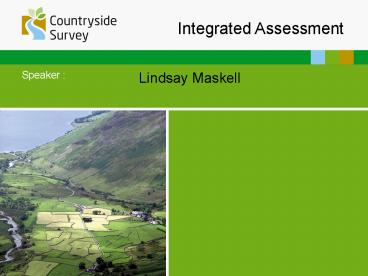Biophysical measurement Indicator: Soil carbon - PowerPoint PPT Presentation
1 / 26
Title:
Biophysical measurement Indicator: Soil carbon
Description:
Biophysical measurement Indicator: Soil carbon – PowerPoint PPT presentation
Number of Views:72
Avg rating:3.0/5.0
Title: Biophysical measurement Indicator: Soil carbon
1
Integrated Assessment
Authors Contributors Prof A.N. Other
- Biophysical measurement / Indicator Soil carbon
2
Overview
- Brief summary of CS extent and type of data
- Overview of Integrated Assessment
- Project structure
- Linking biophysical measurement to ecosystem
service - Attribution and forecasting
- Data database
- hypothesis testing
- statistical development
- Interactions and trade-offs between services
- Up-scaling to catchment modelling and mapping
- Evaluation of approaches
- Questions
3
Countryside Survey sampling strategy
- Sample size
- (km squares)
- 1978 256
- 1984 384
- 1990 508
- 569
- 2007 591
stratified random sample
Based on OS data, climate, soils and geology
classified to give 32 land classes originally,
currently 45
4
Work Package1 Habitats and Features- spatial
mapping
5
WP1 Habitats and Features- Vegetation plots
Margin plots (lt15)
Linear plots Hedges (10,2) Streams (3,2) Roads
(3,2) Boundaries (5) Arable (5)
6
WP2 Land Cover Map 2007
2000
2007
1990
7
WP3 Freshwater Module
- CS2000
- 425 small stream sites
- Macroinvertebrate community
- River Habitat Survey
- Physical environmental data
- Indicative hydrochemistry
- For CS2007,
- 373 stream sites
- Same as CS2000
- Macrophyte community
- Ponds (260 sites)
- Macrophyte community
- Physical environmental data
- Indicative hydrochemistry
8
WP4 Soils
Previously sampled in 1978 and 1998, increased
sample size in 2007 Measurements made Soil
organic matter content Soil pH Bulk
density Microbial community composition Microarthr
opod community Phosphorus Total N
content Mineralisable N Heavy metals
9
WP6 Integrated Assessment
How will ecological impacts of different
pressures translate into effects on ecosystem
services?
- report on current state in potential
of natural resources to provide key ecosystem
services using CS data- main report and
WP6 - assessment of effect of anthropogenic
pressures on the provision of ecosystem
services- WP6 - Attribution - Forecasting
10
Project structure and work flow
11
Linking Biophysical measurement to Ecosystem
service
- (Ecosystem servicethe benefits people obtain
from ecosystems)
12
Linking CS metrics to ecosystem services
- 1a yes CS will be able to say something
- 1b yes CS can say something, but what can be
said will be limited - 2 CS can contribute to but requires further
data/collaboration - 3 CS can't help/there are better data sources
than CS
Haines-Young, R. and M. Potschin (2007)
13
An Ecosystem Service cascade - The logic
underlying the ecosystem services paradigm (after
Haines-Young et al., 2006)
Reference Haines-Young, R. Potschin, M. and D.
Cheshire (2006) Defining and identifying
Environmental Limits for Sustainable Development.
A Scoping Study. Final Overview Report to Defra,
44 pp, Project Code NR0102.
14
Scoping Ecosystem services at 1km square
15
Attribution and Forecasting
16
CS Geodatabase
17
Data requirements, sources issues
- Climate
- Atmospheric deposition- N,S, CO2, Ozone
- Management- June Census, SPS, IACS,
Agri-environment, Fertiliser, pesticides etc. - Net Primary Productivity
- Water quality- EA, N,P, RHS, discharge
- Topography and Landcover- Nextmap, LCM, SSSI, SPA
etc. - Geology Soils
- Hydrology- Flooding, River network
- Socio-economic- popn. density, Farm typology
- Issues confidentiality, spatial and temporal
resolution
18
Biophysical measurements from CS
- Biodiversity
- Soil carbon
- Soil contaminant levels and Nutrient status
- Water quality
NPP Pollination Pests
19
Hypothesis development and testing some examples
- Biodiversity
- There is a positive relationship between
biodiversity and other ecosystem services. - The response of biodiversity to driving
variables depends upon starting productivity,
disturbance and degree of connection to the local
species pool. - Soil Carbon
- When Land Use changes to agriculture soil carbon
will decrease - Water Quality
- There is a negative relationship between
intensity of land use and water quality. - Landuse change has a more significant impact on
water quality than Climate change.
20
Statistical Development
- Development of path analysis tools for signal
attribution - Quantify causal/correlative chains
- Partition variation
- Take account of nested structure of CS data
- Bayesian analysis using WinBUGS offers a very
flexible way of addressing these problems
21
Conceptual attribution model
22
Interactions and Trade-offs between services
23
Interactions and Trade-offs between services
- Relationships between services simple
correlations between variables (Naidoo 2008) - Matrix of services within habitat by square
based on real CS data - Summarise by landclass
- Scaling up- Land Cover Map, other land
classifications, contextual environmental and
socio-economic information - Temporal vs spatial relationships
- Overlay demand map
- Application of scenarios
24
Up-scaling to catchment modelling and mapping
- Example Ribble and Loweswater catchments
25
Evaluation of approaches
- Future outputs
- Report in 2010
- Scientific papers
- Methodological developments
26
Questions
- Are you happy with the links weve made between
measurement and service? - Have we chosen the correct measurements for
further attribution work? - Can you suggest other drivers or external
datasets that we could use? - Can you suggest additional hypotheses for
testing?































